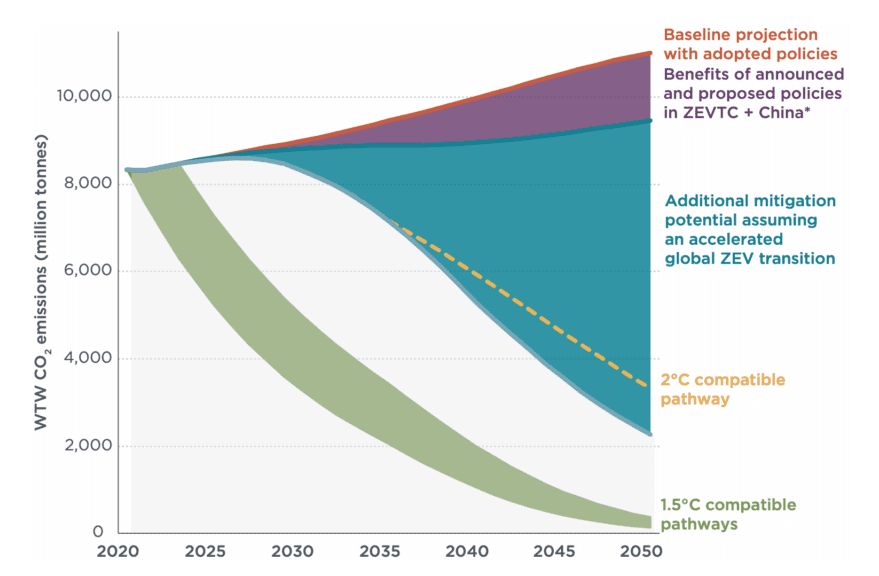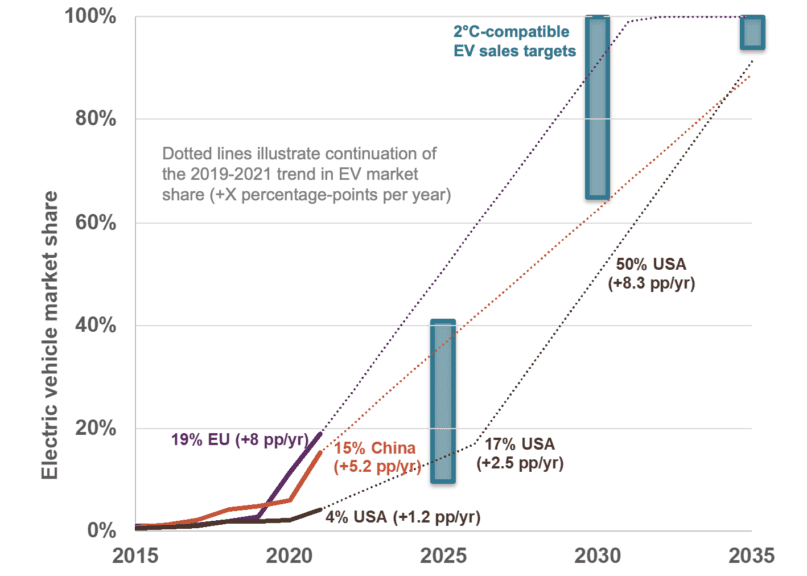Decarbonizing road transport by 2050: Accelerating the global transition to zero-emission vehicles
Blog
Reason for optimism: Europe is on a 2-degree climate pathway for passenger cars
For an antidote to depression brought on by the important news contained in the IPCC Climate Change 2022 Impacts Report released in April, we suggest taking a close look at the electric passenger car sales juggernaut in Europe, which hit a whopping 20% in the first quarter of this year. If Europe can stay on its current trajectory, CO2 emissions from its passenger car fleet will align with a 2-degree climate target, which according to ICCT’s latest global modeling requires 75% EV sales by 2030 and 100% by 2035 in leading markets such as Europe, the United States, and China. Since this is the first time we’ve ever been able to point to a positive climate scenario – if only for one vehicle segment in one region of the world – based on empirical data and credible projections, it’s worth digging into the details.
ICCT’s climate modeling and global commitments
In the fall of 2021, as part of our engagement with the 17-government Zero Emission Vehicles Transition Council, we modeled the projected pace of the ZEV transition considering recent government announcements and proposals, and compared these pathways with goals to limit warming to 2 °C and 1.5 °C. This modeling produced several key takeaways. First, following through on recent government announcements, pledges, and policy proposals could nearly stabilize global vehicle carbon dioxide (CO2) emissions (purple wedge in the figure). Second, and most relevant here, we can see a pathway to staying below 2 °C (dotted line) if governments adopt policies to phase out sales of internal combustion engine (ICE) light-duty vehicles by 2035 and heavy-duty vehicles by 2040 (dark and light blue wedges) and hit interim EV sales milestones in 2025 and 2030. Third, while we do not yet see a pathway to stay below 1.5 °C, we are exploring several ideas that could help reduce the gap (e.g., aggressively scaling up policies to avoid and shift passenger and freight travel demand to lower-carbon modes).

Figure 1. Global well-to-wheel CO2 emissions from light-duty vehicles (cars and vans) and heavy-duty vehicles (trucks and buses) compared to 1.5°C and 2°C compatible emissions pathways.
Another reason for optimism is that a significant number of governments, automakers, and other important stakeholders have committed to phasing out sales of fossil fuel-powered cars, buses, and medium and heavy trucks by dates consistent with our two-degree trajectory. In December 2021, two major announcements came out of the United Nations’ climate change conference in Glasgow (COP26): the COP26 declaration on accelerating the transition to 100% zero-emission cars and vans (the “Glasgow Declaration”) and the memorandum of understanding on zero-emission medium- and heavy-duty vehicles (the “Global MOU”). The Glasgow declaration includes pledges from national governments, subnational governments, automakers, fleets, investors, and other signatories. Among them, 28 national governments pledged to work toward 100% zero-emission car and van sales by 2040 globally and 2035 for leading markets. The Global MOU, to date signed by 15 national governments, includes pledges to work toward 100% zero-emission truck and bus sales by 2040 with an interim goal of 30% by 2030.
These pledges are supported by extensive international collaborations, such as the ZEV Transition Council, and enabled by progress made by other initiatives, such as the ZEV Alliance. Those international collaborations also saw significant developments: the United States joined the ZEV Transition Council as co-chair alongside the United Kingdom, and the ZEV Alliance added Chile and Costa Rica, the first upper middle-income countries among its membership. International initiatives such as these will be crucial to build on commitments to the ZEV transition and implement effective policy measures to ensure this transition happens at the scale and pace needed to reach climate goals.
Comparison of EV sales in leading auto markets with a two-degree climate trajectory
Whether or not we exceed carbon budgets is a function of cumulative emissions. As a result, ICE phase-out targets by 2035 for cars and 2040 for trucks and buses must be accompanied by interim milestones in 2025 and 2030. According to ICCT’s modeling, leading markets will need to hit ZEV sales shares of 90% for buses, 75% for cars, 50% for medium-duty trucks, and 40% for heavy-duty trucks by 2030.
Even with these ambitious milestones, we can report that the European Union (EU) simply needs to maintain its current market trajectory to align with a two-degree emissions pathway for cars and vans. From 2019 to 2021, public policies — led by the EU’s CO2 emission standards — drove an incredible ramp-up in EV production and sales. According to ICCT’s Market Monitor, the EU’s market share of electric passenger vehicles grew from 3% in 2019, to 11% in 2020, to 19% in 2021, an increase of 8 percentage points per year. If the EU maintains this pace of market transition, it would exceed a 90% EV passenger car sales share in 2030 and achieve 100% electrification by 2032. To ensure the current pace of EV uptake continues, though, the EU would need to strengthen its “Fit for 55” proposal for CO2 standards for cars and vans accordingly.
China, the world’s largest passenger car market, saw a similar increase from 5% to 15% from 2019 to 2021, an increase of 5 percentage points per year. China’s commitment to electrification is driven by a combination of new energy vehicle sales targets, fuel economy standards, and fiscal incentives. To align with a 2°C-compatible pathway, China needs to raise its current annual EV sales growth from 5 to 6 percentage points per year.
In the United States, the market share of electric passenger vehicles grew only 1% per year from 2019 to 2021. The United States Environmental Protection Agency estimates its latest light-duty vehicle GHG standards will achieve 17% electric vehicle sales in 2026, an increase of 2.5 percentage points per year from 2021 to 2026. The next phase of GHG standards will need to increase the electric vehicle market share by 8 percentage points per year from 2026 to 2030 to achieve Biden’s goal of 50% electric vehicle sales by 2030.

Figure 2. Battery-electric and plug-in hybrid electric vehicle market share for new passenger vehicles in select markets from 2015 to 2021 compared with 2 °C compatible EV sales targets. Data for China and the U.S. are from Marklines. Data for Europe are from the European Environmental Agency (EEA) and Dataforce. Data for China and Europe only include passenger cars. Data for the U.S. also include passenger light trucks.
Policies under development in Europe and North America
We expect lots of policy action to take place over the next 12 to 18 months in all major markets.
In April, California released its Advanced Clean Cars II program that proposed zero-emission vehicle sales targets of 35% by 2026, 68% by 2030 and 100% by 2035—consistent with the governor’s executive order. And the United Kingdom as part of its Net Zero Strategy has announced that it will adopt a ZEV mandate by 2024 and is currently seeking public comment on critical design features.
In North America, the United States pledged to cut greenhouse gas emissions in half by 2030, passed legislation to spend $7.5 billion on a national network of charging stations for electric vehicles, and is developing greenhouse gas standards for light- and heavy-duty vehicles. Canada has committed to develop a ZEV rule to achieve at least 60% EV sales for passenger cars by 2030 and 100% by 2035. In Europe, triggered by the Fit for 55 package, the European Commission proposed a CO2 standard for passenger cars and vans that would phase out internal combustion vehicles by 2035, and it is currently working on a revised CO2 regulation for heavy-duty vehicles. In March of this year, the new German government announced its support for the European Commission’s passenger car CO2 proposal, and it is expected to extend EV fiscal incentives to 2025.
When considering the stringency and pace of the electrification transition as reflected in new policy, we expect that these governments will take into consideration Europe’s emerging success story and the knowledge of what is required to align with a below-2-degree climate trajectory. To align with a 1.5-degree compatible trajectory will require additional steep reductions from policies to encourage shifting to lower-carbon modes of travel such as rail, shipping, walking and biking.
